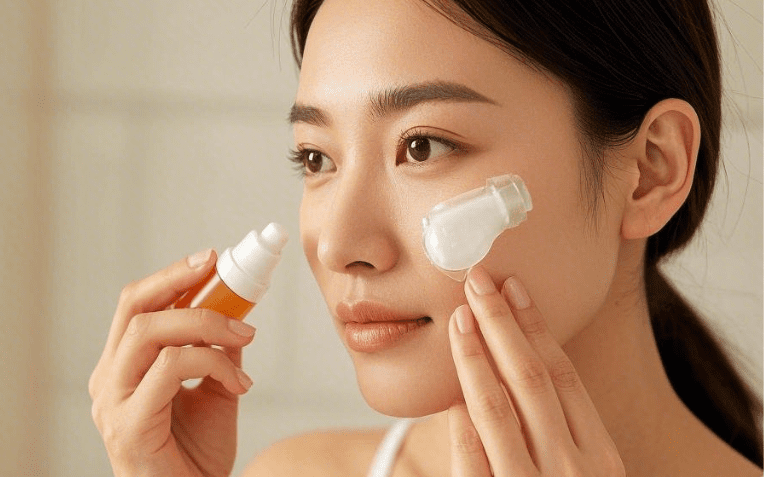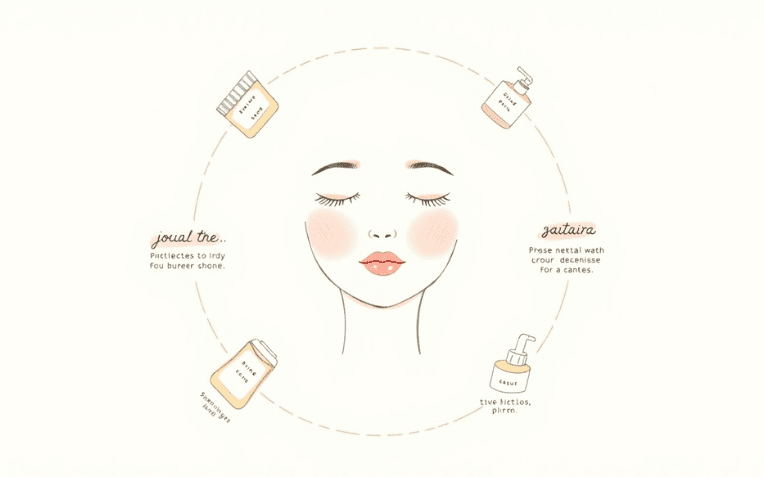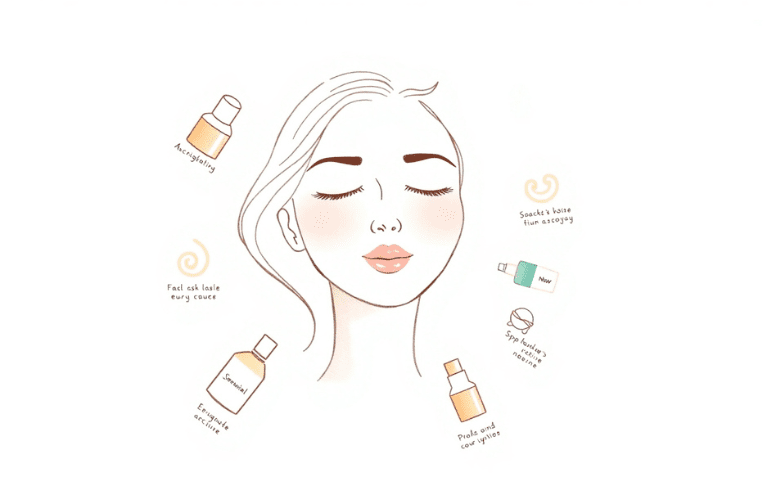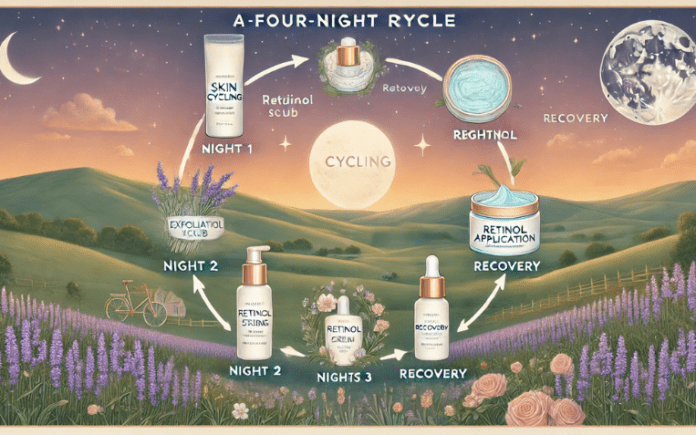Table of Contents
Skin Cycling Routine
In the ever-evolving world of skincare, new trends come and go, but one that has gained significant traction for its effectiveness and simplicity is skin cycling Routine. This structured approach to skincare involves rotating products and ingredients in a deliberate sequence, offering your skin a balanced routine while preventing overuse of active ingredients.
One innovative approach gaining traction is the concept of skin cycling—a systematic method that promotes skin health by alternating between different types of treatments. Here’s a deep dive into the concept, benefits, and step-by-step guide to adopting a skin cycling routine.
| Day | Routine Step | Purpose | Recommended Products | Key Benefits |
| Day 1 | Exfoliation Night | Removes dead skin cells, unclogs pores, and preps skin for active ingredients. | Chemical exfoliants (e.g., glycolic acid, salicylic acid), gentle moisturizer. | Brightens skin enhances product absorption, and smooths texture. |
| Day 2 | Retinoid Night | It boosts collagen production, reduces fine lines, and improves skin tone and texture. | Retinol or retinoids, hydrating moisturizer. | Addresses wrinkles, uneven texture, and dark spots. |
| Day 3 | Recovery Night | Repairs skin barrier, restores hydration and reduces inflammation. | Hydrating serums (e.g., hyaluronic acid), nourishing moisturizers (e.g., ceramide-based). | Strengthens skin barrier, soothes sensitivity, and locks in moisture. |
| Day 4 | Recovery Night | Continues to focus on hydration and barrier repair. | Same as Day 3. | Maintains balance and preps skin for the next cycle. |
Notes:
- Flexibility: Adjust the number of recovery nights based on your needs (e.g., sensitive skin may require more recovery days).
- Consistency: Always use sunscreen daily, especially when using exfoliants or retinoids, as they increase sun sensitivity.
- Customization: Select products based on your skin type (e.g., salicylic acid for oily skin, lactic acid for sensitive skin).
What is Skin Cycling?
Skin cycling is a skincare technique that organizes your routine into a multi-day cycle. It focuses on using active ingredients, like retinoids or exfoliants, on specific days, followed by recovery days when your skin is nourished and restored.

This method prevents irritation and promotes optimal skin health by avoiding daily overloading your skin with powerful ingredients.
The Science Behind Skin Cycling
Our skin operates on a natural renewal process, shedding dead skin cells and regenerating every 28 days. When this process is disrupted—by over-exfoliation, harsh chemicals, or improper skin care—it can lead to irritation, redness, and breakouts.
Skin cycling aligns with your skin’s natural rhythm, giving it what it needs when needed. By alternating active and recovery days, you allow your skin to heal and strengthen its barrier, reducing the risk of damage.
Key Benefits of Skin Cycling
1. Prevents Over-Exfoliation
Exfoliating ingredients like AHAs and BHAs can do wonders for unclogging pores and brightening skin, but overuse can lead to sensitivity and a compromised skin barrier. Skin cycling ensures exfoliation is done in moderation.
2. Reduces Irritation from Actives
Ingredients like retinol can be transformative but also harsh, especially for beginners. By spacing out their usage, you minimize irritation and redness while still reaping the benefits.
3. Strengthens the Skin Barrier
Incorporating recovery days focused on hydration and barrier repair helps rebuild the skin’s natural defenses, leading to healthier, more resilient skin.
4. Customizable for All Skin Types
Whether you have sensitive, oily, or combination skin, skin cycling can be tailored to suit your specific needs and concerns.
5. Improves Long-Term Results
Consistency is key in skincare, and skin cycling promotes a sustainable routine that delivers visible improvements over time without overwhelming your skin.

How to Start Your Skin Cycling Routine?
A basic skin cycling routine spans four nights: exfoliation night, retinoid night, and two recovery nights. Here’s a step-by-step guide:
Night 1: Exfoliation Night
- Purpose: Remove dead skin cells and prep the skin for better product absorption.
- Steps:
- Cleanse your face with a gentle cleanser.
- Apply a chemical exfoliant like glycolic acid or salicylic acid. Avoid physical scrubs, which can be too harsh.
- Follow with a hydrating moisturizer to soothe and protect your skin.
Night 2: Retinoid Night
- Purpose: Boost collagen production, improve skin texture, and reduce signs of aging.
- Steps:
- Cleanse and pat your face dry.
- Apply a pea-sized amount of retinol or a prescription-strength retinoid.
- Use a nourishing moisturizer to combat potential dryness.
Nights 3 and 4: Recovery Nights
- Purpose: Repair the skin barrier and provide hydration.
- Steps:
- Cleanse with a gentle, non-stripping cleanser.
- Apply a hydrating serum containing hyaluronic acid or niacinamide.
- Lock in moisture with a rich, barrier-repairing cream or balm.

Tips for Success with Skin Cycling
- Start Slow
If you’re new to active ingredients, begin with lower concentrations and gradually increase as your skin adapts. - Listen to Your Skin
Pay attention to how your skin reacts. If irritation occurs, extend recovery nights or reduce the frequency of active ingredients. - Use Sunscreen Daily
Active ingredients can make your skin more sensitive to the sun. Apply a broad-spectrum SPF 30 or higher every morning. - Customize Based on Your Needs
You can tweak the cycle length—some may benefit from a five-night cycle, while others prefer three nights. - Don‘t Skip the Basics
A good cleanser, moisturizer, and sunscreen are essential no matter the stage of your skin cycling routine.
Who Can Benefit from Skin Cycling?
Beginners
Skin cycling simplifies the process into manageable steps for those overwhelmed by complex skincare routines.
Sensitive Skin Types
This method is gentle and prevents overloading the skin with harsh actives, making it ideal for sensitive skin.
Aging Skin
By incorporating retinoids and exfoliants strategically, skin cycling can address fine lines, wrinkles, and uneven texture without irritating.
Acne-Prone Skin
Targeted exfoliation and retinoid use can help clear breakouts and reduce post-acne marks.

Combining Skin Cycling and Exercise for Maximum Glow
To achieve optimal results for clearer and healthier-looking skin:
- Follow your nighttime skin cycling routine consistently.
- Incorporate regular workouts like cardio or yoga to improve circulation and reduce stress.
- Stay hydrated during exercise sessions to support both your body and skin.
- Always cleanse your face after working out to prevent clogged pores from sweat buildup.
- Use sunscreen during outdoor activities to protect against UV damage—a key factor in premature aging.
Myths About Skin Cycling
1. “It’s Only for Beginners”
While skin cycling is great for those new to actives, even skincare veterans can benefit from its structured approach to prevent overuse and irritation.
2. “It‘s Too Simplistic”
The simplicity of skin cycling doesn’t undermine its effectiveness. A streamlined routine often delivers better results by focusing on what works.
3. “Results Take Too Long”
While patience is required, many users notice skin texture and clarity improvements within a few weeks.
The Future of Skin Cycling
As more people recognize the importance of a balanced skincare routine, skin cycling becomes a go-to approach for sustainable skin health. Dermatologists and skincare brands are increasingly advocating for this method, creating products tailored for specific stages of the cycle.
Conclusion
Skin cycling is a game-changing routine that prioritizes your skin’s health and resilience. By giving your skin active ingredients on some nights and resting on others, you can achieve clearer, brighter, and more balanced skin without the risk of overdoing it.
Whether you’re new to skincare or looking to simplify your routine, skin cycling offers a practical, effective solution that aligns with your skin’s natural needs.
Apart from that if you want to know about “Exploring Central Kent: The Heart of the Garden of England” then please visit our “Featured” Category.
FAQs
Skin cycling is a skincare routine alternating between active ingredient nights (exfoliation and retinoids) and recovery nights to balance effectiveness and skin health.
A standard skin cycling routine spans four days: one exfoliation night, one retinoid night, and recovery nights.
Skin cycling suits all skin types, including sensitive, acne-prone, and aging skin. It’s especially helpful for beginners or those experiencing irritation from overusing active ingredients.
Yes! You can modify the cycle based on your skin’s needs. For example, you might extend recovery nights or shorten the cycle if your skin tolerates actives well.













